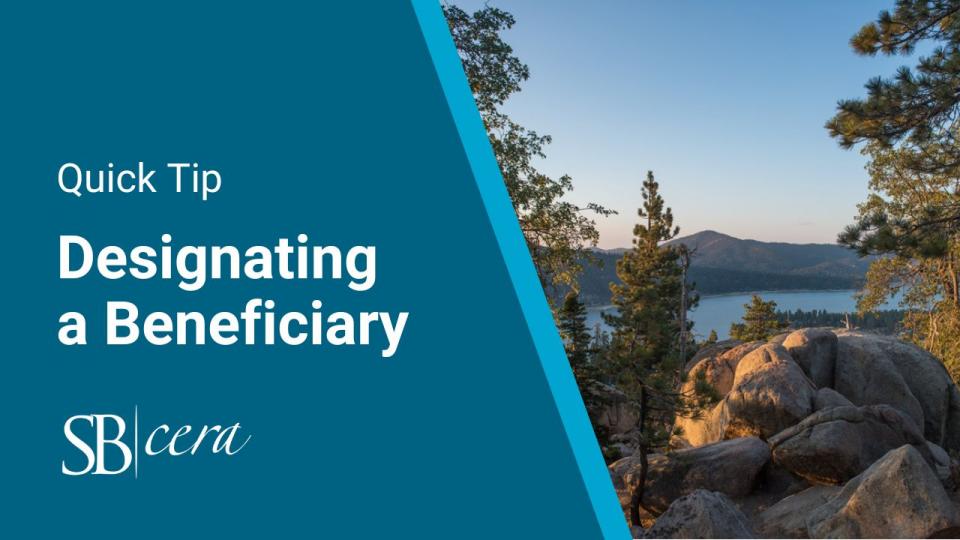A beneficiary is the person the member has named in writing to receive such benefits provided by SBCERA upon the member’s death. The Primary Beneficiary is the first-named person or persons who would receive these benefits from SBCERA. The Alternate Beneficiary is the person or persons who would receive these benefits from SBCERA if there are no living primary beneficiaries on the date of the member’s death.
If a member dies before retirement, the appropriate death benefit is paid to the beneficiary or beneficiaries the member designated when the member joined SBCERA or, subsequently, on an SBCERA Beneficiary Designation/Change form.

A surviving spouse or minor children, even if not the named beneficiary, may have certain rights superseding the rights of the named beneficiary. If the member does not leave a surviving spouse when the member dies but does leave surviving unmarried children under the age of 18, a legally-appointed guardian of the children shall make an election for all death benefits. The court must appoint a legal guardian over the estate of the minor children. If a biological parent exists, that parent still must be appointed the guardian of the estate of the minor children.
If a member has not designated a beneficiary, or if the beneficiary is no longer living, the benefit will be paid to the member’s estate. Please be aware that a member cannot designate a charity as a beneficiary to receive SBCERA death and/or survivor benefits.
If the member was a deferred vested member at the time of death, the designated beneficiary is only eligible for a lump-sum refund/rollover of the refundable contributions and interest. If the member was a deferred reciprocal member, the benefit options available will be coordinated between SBCERA and the reciprocal system. A person who has terminated employment and taken a refund of accumulated contributions is considered a terminated member. As such, said person has ceased to be a member of SBCERA’s retirement plan and no death benefits will be payable to the beneficiary.
When the member applies for retirement, the member will designate a beneficiary. This will supersede any previous beneficiary designation.
The post-retirement death benefits depend on which payment option the member chooses and who is designated as the beneficiary for a continuance of the retirement benefit:
Unmodified Option
- The eligible spouse/domestic partner will receive a lifetime monthly continuance of 60% of the benefit the member was receiving (or 100%, if the member retired with a service-connected disability). When the spouse/domestic partner dies, payments will stop and no further benefits will be paid.
- For a spouse/domestic partner to be eligible, the marriage or registered domestic partnership date must be at least one year before the date of retirement (or, for a service-connected disability retirement, one day before the date of retirement).
- Unmarried minor children may receive a monthly continuance that is 60% of the benefit the member was receiving, divided among them (100% if the member retired for a service-connected disability).
- Children will remain eligible until they marry or reach age 18 (or age 22 if they remain unmarried and enrolled as full-time students in an accredited school). When they cease to be eligible, payments will stop and no further benefits will be paid.
Option 1
- Any unused refundable contributions will be paid to the beneficiary in a lump-sum upon the member’s death. No further benefits will be paid.
- The beneficiary designation may be changed at any time if the member has elected Option 1.
Option 2
- The beneficiary will receive a lifetime continuance of 100% of the benefit the member was receiving When the beneficiary dies, payments will stop and no further benefits will be paid.
Option 3
- The beneficiary will receive 50% of the benefit the member was receiving for the beneficiary’s lifetime. When the beneficiary dies, payments will stop and no further benefits will be paid.
Burial Allowance
Regardless of which payment option is selected, a lump-sum burial allowance of $1,000 will be paid to the beneficiary or estate. If the member was a retiree with reciprocity, only one such benefit is payable, and it will be paid by the retirement system the member was with last as an active member. Check with the reciprocal system to verify the lump-sum burial allowance amount that it will pay.
If a loved one has died and you need assistance with any questions you have as a beneficiary, please refer to the Beneficiary Checklist for assistance or contact SBCERA.